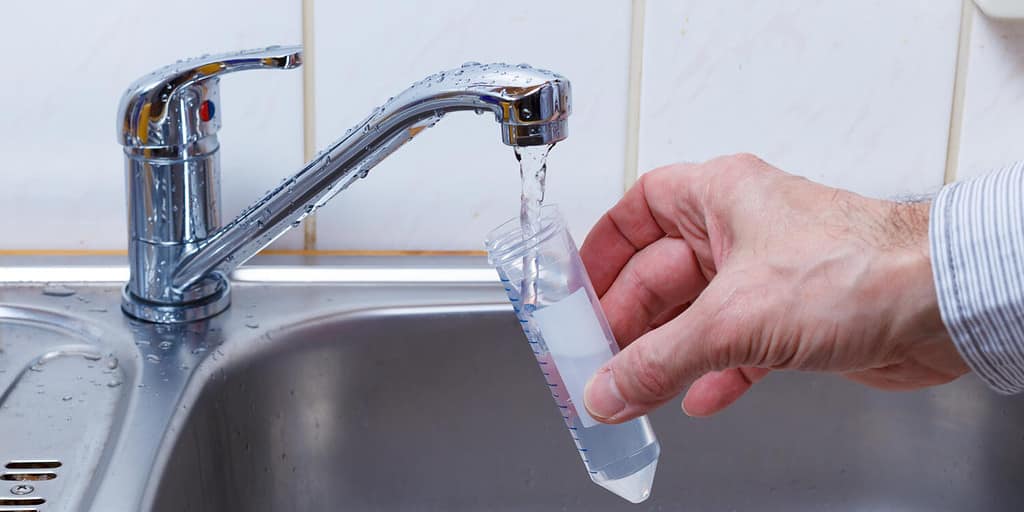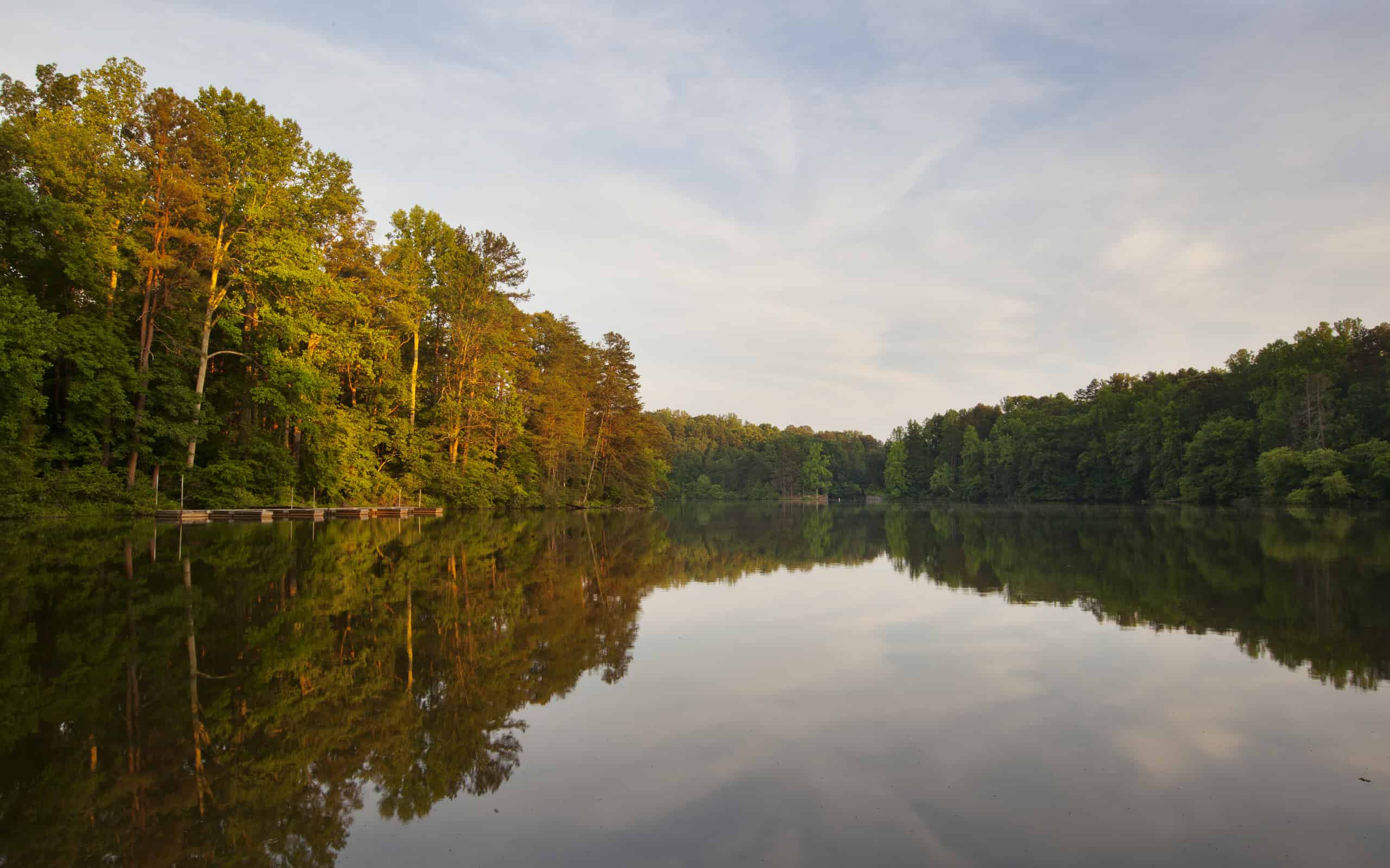Located in North Carolina, Lake Norman is just north of Charlotte, making it an excellent place to visit. The streets in the area are historic and full of restaurants, galleries, and shops. Many go to Lake Norman to enjoy water activities, including fishing and boating. Other outdoor activities popular in the area are mountain biking and hiking, so there’s something for everyone.
Lake Norman is an artificial lake that took nearly five years to complete. It was built to construct a dam but became a popular area for locals and tourists. However, there have been many reports of contamination in the water at Lake Norman, leading many people to wonder, “How polluted is Lake Norman?” Let’s find out the answer!
Is Lake Norman Safe to Swim in?

Cornelius, NC, is one of eight towns on Lake Norman’s banks.
©Wirestock/iStock via Getty Images
Pollution can be worrisome, and contaminants in large amounts can be detrimental to your health. During the summer of 2023, a portion of Lake Norman had a “No Swim” advisory that was later lifted.
Surface water quality tests from Charlotte, NC, show Lake Norman is safe for swimming. So, the water sometimes has advisories but is safe for swimming during other times. Stay aware, check for posted signs, and use your best judgment when entering the water.
Lake Norman is one of the best swimming spots near Charlotte, NC. While pollution reports are alarming, efforts are made to keep it clean.
Radioactivity Contributes to the Pollution of Lake Norman

Previously, the pollution of Lake Norman resulted from radium from a coal-fired plant.
©Bilanol/Shutterstock.com
In the past, Lake Norman was affected by radium from Duke Energy’s Marshall Steam coal-fired plant. The radium raised the radioactivity level until it reached 2.5 times the drinking water standard. Thallium levels nearby also exceeded groundwater standards.
However, despite these alarming results, many professionals claimed there wasn’t a danger in the drinking water or groundwater. Third-party testing was completed one month after the original Waterkeeper Alliance news release and verified safe levels.
Fecal Coliform
News of pollution at Lake Norman surfaced again, with a waterfront community, Lake Norman Woods, being the cause. State environmental officials fined the upscale community for high levels of bacteria and chemicals released into the lake.
High levels of nitrogen, ammonia, and fecal coliform (bacteria from waste) were caused by issues with the equipment at Lake Norman Woods’ sewage treatment plant. The Fecal Coliform levels reached more than 500% of state limits, while nitrogen and ammonia levels reached 265%.
Later, multiple reports surfaced of sewage spills into Lake Norman. In one instance, a broken pipe led to almost 900 gallons of sewage dumping into the lake. Another situation caused 8,000 gallons to spill into the lake from a sewage manhole after a sewage line became blocked.
These instances aren’t the only occurrences of sewage contaminating Lake Norman. It seems to have become common to see news articles relaying information about another contamination. Officials have recognized the issue and thus implemented means of cleaning and maintaining the lake.
Polychlorinated Biphenyls (PCBs)

Lake Norman offers beautiful views but can harbor harmful chemicals, including PCBs.
©skiserge1/iStock via Getty Images
The North Carolina Department of Health and Human Services released statements that fish found in Lake Norman have had high levels of PCBs. PCBs are unsafe carcinogenic chemicals that sometimes lead to cancer and other health concerns. These chemicals can also increase your risk of developing immune system effects or liver trouble.
What’s Being Done About Lake Norman Pollution
The fines from the State environmental officials for water pollution are only the start of ongoing efforts to clean and maintain the lake. Response teams identify and prevent leaks, helping clean up the lake. These teams can stop the leak, clean the area, and dilute contaminants.
The Climate Reality Project, a non-profit, focuses on advocating for and teaching about climate change and how it affects the area. They aim to find solutions for agricultural businesses to help keep the water clean. The Department of Environmental Quality is pushing new limits and standards for coal ash. However, they may delay the change, much to the dismay of those in the Lake Norman area.
Comparing Pollution of Lake Norman to Other Nearby Lakes

Belews Lake in North Carolina is another lake affected by coal ash.
©Eifel Kreutz/iStock via Getty Images
Water quality data is available publicly and allows you to verify if the water you drink or swim in is safe. You can also learn about other lakes and rivers in the Lake Norman area by visiting the Catawba Riverkeeper website.
Coal Ash
Duke University and Appalachian State University scientists found that coal ash has significantly contaminated more than just Lake Norman. Other swimming spots in North Carolina had polluted water and sediments.
These experts found that bottom sediments show the different types of coal ash in the lakes. Sediments can also show when and where higher toxin concentrations occurred. Coal ash can impact area lakes through various methods, which can often be determined based on sediment type.
Atmospheric emissions likely caused particles to settle into nearby land before the Clean Air Act required scrubbers to prevent particles from getting into the air. When this occurred, the coal ash would wash into the lake. There have also been instances of effluent discharge when contaminants get into lakes.
Hurricanes and tropical storms also cause floods in the area that cause coal ash impoundments to overflow. When they overflow, the contaminants leak into lakes, causing further pollution.
Coal ash contains hazardous metals linked to cancer and other health issues. The lakes affected by coal ash include:
- Hyco Lake
- Mayo Lake
- Belews Lake
- Mountain Island Lake
- Lake Sutton
Other Contaminants in Nearby Lakes

Residents should look up the water quality for Lake Norman and other nearby lakes.
©luchschenF/Shutterstock.com
When considering how polluted Lake Norman is, comparing it to other areas is essential, it can help determine environmental patterns in the area.
- Mountain Island Lake: This lake has fish consumption advisories for high levels of PCBs and mercury.
- Lake Davidson: You’ll sometimes find “no swim” advisories for high bacteria levels.
- Lake Wylie: Fecal coliform bacteria levels sometimes increase in this lake, so it sometimes isn’t suitable for swimming. It also contains contaminants like PCBs and mercury.
Thank you for reading! Have some feedback for us? Contact the AZ Animals editorial team.








